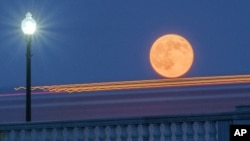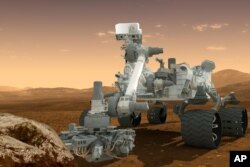Many people are looking forward to something unusual in the skies this weekend. In fact, astronomers note that an event like this last happened 33 years ago!
People will have a chance to witness a celestial event high above them. A lunar eclipse will take place at the same time as a supermoon, when the full moon is closest to earth. The best time to watch this supermoon eclipse will be at sunset Sunday night or before sunrise on Monday, depending on where you live.
A lunar eclipse is when the moon passes into the darkness of Earth’s shadow. This eclipse is special. The full moon will appear brighter and bigger because it is closer to Earth than at any other time in its orbit.
Noah Petro is with the National Aeronautics and Space Administration. He works at NASA’s Goddard Space Flight Center.
"So we will go from being very bright to turning this beautiful red color, the effect of the sunrises and sunsets of the Earth being projected onto the lunar surface."
The last time the supermoon and a lunar eclipse took place at the same time was in 1982.
NASA scientists have been watching the moon for a long time. Back in the 1960s, the space agency’s Apollo program put a man on the moon. In more recent years, the agency has collected information with its Lunar Reconnaissance Orbiter. The orbiter flies as low as 20 kilometers above the moon's surface. Noah Petro says its pictures are leading to a better understanding of the moon.
"…Impact craters that have formed in the six years that we have been there. We are seeing evidence of migrating water across the surface. Not a lot of water, a small amount of water. But still the view that the moon is a static unchanging place is now completely different."
Scientists at Goddard have predicted eclipses a thousand years into the future. Noah Petro says the predictions are not difficult so long as scientists know where the earth, sun and moon are at any given time.
He adds that some moon rocks date back 4.5 billion years to the earliest history of our solar system.
"The record of that portion of time in our solar system is almost all but gone from the earth. So in order to understand what was happening, just after the planets formed, studying the surface of the moon is one of the most interesting and best places to do that. And so when we look at the moon, we’re really looking into the deep history of the earth as well, and, I think, from that we learn a lot about how our planet has changed, and how all planets have changed over time."
The supermoon eclipse will take place Sunday after the sun sets in North America and all of South America. It can be seen early Monday morning in parts of Europe, the Middle East and Africa.
The next time to witness such an eclipse will be 2033.
I’m Marsha James.
VOA’s Rosanne Skirble reported on this story. Marsha James adapted it for Learning English. George Grow was the editor.
________________________________________________________________
Words in This Story
celestial – adj. of or relating to the sky
lunar eclipse – n. when the moon passes directly behind the earth and is hidden in the darkness
shadow – n. an area where an object blocks light from the sun or electric lighting
crater – n. a large round hole on the surface of a planet or the moon, caused by something falling from the sky
static – adj. showing little or no change or action
portion – n. a part or piece of something









